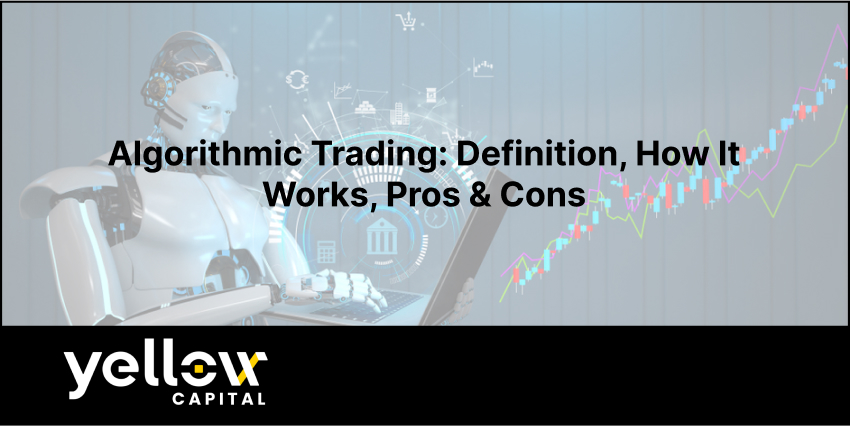- August 8, 2024
- Category: Crypto

Algorithmic trading encompasses the utilization of three distinct categories of algorithms: execution algorithms, profit-seeking or black-box algorithms, and high-frequency trading (HFT) algorithms. Despite their operational intersections in practical applications, these categories represent automated mechanisms dedicated to financial transactions and decision-making, leveraging data such as price, timing, volume, and others, within predefined rule sets to address trading challenges traditionally managed by human financial experts.
Core Takeaways
The main idea behind algorithmic trading is to rely on computational algorithms based on rigorous processes and rules, in requirement to enable trade executions. The regulators and policymakers, in the same breath, have over the years been fault-finding in the black box or profit-seeking algorithms because of their complex processes.
The start of the eighties showed an increase in the usage of algorithmic trading, from large institutions to small institutions, even major trading firms, for lots of objectives. This is all good as it has an advantage, for example, of better speed of execution and cost efficiency; however, there are also potential dangers in algorithmic trading since it can act as an amplifier of adverse market dynamics, possibly even causing sudden market collapses and liquidity problems.
Algorithmic trading involves complex mathematical models conducted by a human operator, who ultimately has to make trading decisions. High-frequency algorithmic trading permits the execution of tens of thousands of trades in a second, more so by firms. It includes tasks such as order execution, arbitrage, and trend trading strategies.
In-depth Exploration
The proliferation of algorithmic trading was significantly propelled by the advent of computerized trading systems in the American financial markets during the 1970s. A notable milestone was the introduction of the designated order turnaround system by the New York Stock Exchange in 1976, facilitating the electronic routing of orders. This period marked the beginning of a transformative era that saw exchanges augmenting their electronic trading capabilities, culminating in a scenario where, by 2009, over 60% of all U.S. trades were executed via computers.
Diverse Algorithms in Trading
Trading algorithms are designed as a set of rules or instructions crafted to automate trading decisions. Simple single-stock algorithms and complex black-box algorithms, which scour market conditions, price movements, and other financial data to optimize execution times to get the best cost-profit ratio, are among the lot. It combines with finance and has brought in a plethora of technical jargon, which we will try to simplify here.
While terminologies might vary slightly across different trading firms, the following provides an overview of the broad applications of algorithmic trading:
- Arrival price algorithms focus on executing trades as closely as possible to the stock price at the time the order was placed, aiming to minimize market impact and the risk associated with price movements following the order placement.
- Basket algorithms, also known as portfolio algorithms, are designed to execute orders while considering their impact on other decisions and securities within a portfolio, factoring in constraints like cash balancing and risk management for the portfolio as a whole.
- Implementation shortfall algorithms are programmed to minimize the cost incurred from the deviation of the executed order from the planned decision price, addressing the challenge of implementation shortfall.
Algorithms based on a percentage of volume adjust order sizes in response to real-time market trading volumes, striving to maintain a predetermined percentage of the total market volume, thus balancing market impact against timing considerations.
Illustrative Example
Consider an algorithm programmed to purchase 100 shares of a specific stock of Company XYZ whenever the stock’s 75-day moving average crosses above its 200-day moving average. This condition, known as a bullish crossover in technical analysis, often signals an upward price trend. The designated execution algorithm would monitor these averages and autonomously execute the trade upon the fulfillment of this condition, obviating the need for continuous market monitoring and enabling precise, emotion-free trading based on specific, pre-established rules.
Black Box Algorithms
The key difference with algorithms described before is the fact that black-box ones represent a different philosophy of operation. This is one of the key philosophies when it comes to AI applications within finance. Of course, these algorithms, while pursuing set goals, are market-condition and other external factors driven to determine a way to reach an objective most profitably, very typically without transparent access and insight into their internal operations — up to the developers. This lack of transparency has raised huge concerns about accountability and risk management in algorithmic trading.
Open Source Contributions
The algorithmic trading landscape has also been enriched by the open-source movement, enabling a broader spectrum of participants, including hobbyists and non-professionals, to engage in the development and refinement of trading algorithms. This collaborative environment fosters innovation and knowledge sharing, allowing individuals to contribute to and benefit from collective advancements in the field.
Balancing Benefits and Drawbacks
Algorithmic trading offers several advantages, such as increased transaction speed, precision, and the elimination of emotional biases from trading decisions. However, it is not devoid of challenges, including the risk of system failures, market manipulation, and the need for continual adaptation to evolving market and regulatory landscapes.
Embarking on Algorithmic Trading
To commence algorithmic trading, one must acquire programming skills, gain a deep understanding of financial markets, and develop or select a viable trading strategy for back testing and implementation, potentially through a brokerage platform that supports algorithmic trading functionalities.
Conclusion
Algorithmic trading, with its capacity to offer speed, efficiency, and objectivity in trading decisions, represents a significant evolution in the financial trading domain. It enables automated execution of trading strategies, reduces the risk of human error, and enhances information security. Nonetheless, it is accompanied by considerable risks, including dependency on complex technologies, the potential for increased systemic risk, and the challenges posed by market volatility and technical anomalies.
Add a comment
You must be logged in to post a comment.

